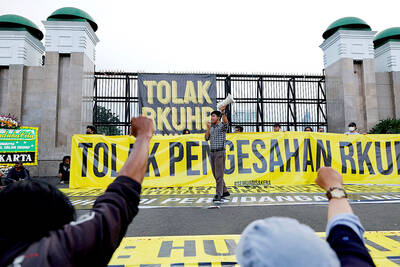Hundreds of South Koreans gathered in downtown Seoul on Saturday as the city officially reopened a stream that had been hidden under cement paving stones for nearly 50 years.
The Cheonggyecheon, which runs 5.8km through central Seoul, was opened to the public after a two-year multimillion-dollar face-lift ordered by Mayor Lee Myung-bak, who had pledged to recover the city's ecological landscape.
"It seemed like a far-fetched dream when they first said they will restore the stream," said 59-year-old Yoo Young-koo, who runs a business in central Seoul. "It's really nice to have a place to rest and take a stroll right in the center of the city."
South Korea's drive for industrialization in the 1960s and 1970s has helped the country become the world's 11th-largest economy, but it has also trapped major cities like Seoul in walls of concrete.
The US$380 million project involved demolishing an elevated highway that was built on top of the Cheonggyecheon, which was paved over in 1958-61 to prevent flooding and pollution.
Now the stream flows alongside the heavily congested roads of downtown Seoul, adorned with artistic sculptures, fountains and plant-filled paths. Each of the 22 bridges that cross the stream is distinct in style.
"The city looks a lot brighter and cleaner," said 34-year-old Lee Ho-chung, who came to see the opening ceremony with his wife, two children and mother-in-law. "It's amazing that we have a stream flowing in the heart of the city. We will come more often for our family outings."
The official opening ceremony was to begin on Saturday evening with a parade of people carrying jugs of water collected from major rivers and lakes throughout the country. The water will be poured into the Cheonggyecheon in a symbolic gesture calling for unity and reunification of the Korean Peninsula, Seoul officials said.
Not everyone hailed the city's new look.
The Korean Federation of Environmental Movement issued a statement on Saturday criticizing the Cheonggyecheon project as "nothing more than an exhibition."
The group said the Seoul city government didn't make enough effort to restore the natural habitats of animals and plants along the waterway and also criticized the large amount of money to be spent on pumping water into the stream.
Some 120,000 tons of water will be pumped daily into the Cheonggyecheon, which is naturally dry. The environmental group estimated at least 1.8 million won (US$1.7 million) will be spent annually to manage the stream's upkeep.
"The first stage of Cheonggyecheon's restoration is complete, but Seoul city will have to exert efforts to make the Cheonggyecheon sustainable," the group said.

Shamans in Peru on Monday gathered for an annual New Year’s ritual where they made predictions for the year to come, including illness for US President Donald Trump and the downfall of Venezuelan President Nicolas Maduro. “The United States should prepare itself because Donald Trump will fall seriously ill,” Juan de Dios Garcia proclaimed as he gathered with other shamans on a beach in southern Lima, dressed in traditional Andean ponchos and headdresses, and sprinkling flowers on the sand. The shamans carried large posters of world leaders, over which they crossed swords and burned incense, some of which they stomped on. In this

Indonesia yesterday began enforcing its newly ratified penal code, replacing a Dutch-era criminal law that had governed the country for more than 80 years and marking a major shift in its legal landscape. Since proclaiming independence in 1945, the Southeast Asian country had continued to operate under a colonial framework widely criticized as outdated and misaligned with Indonesia’s social values. Efforts to revise the code stalled for decades as lawmakers debated how to balance human rights, religious norms and local traditions in the world’s most populous Muslim-majority nation. The 345-page Indonesian Penal Code, known as the KUHP, was passed in 2022. It

Near the entrance to the Panama Canal, a monument to China’s contributions to the interoceanic waterway was torn down on Saturday night by order of local authorities. The move comes as US President Donald Trump has made threats in the past few months to retake control of the canal, claiming Beijing has too much influence in its operations. In a surprising move that has been criticized by leaders in Panama and China, the mayor’s office of the locality of Arraijan ordered the demolition of the monument built in 2004 to symbolize friendship between the countries. The mayor’s office said in

‘TRUMP’S LONG GAME’: Minnesota Governor Tim Walz said that while fraud was a serious issue, the US president was politicizing it to defund programs for Minnesotans US President Donald Trump’s administration on Tuesday said it was auditing immigration cases involving US citizens of Somalian origin to detect fraud that could lead to denaturalization, or revocation of citizenship, while also announcing a freeze of childcare funds to Minnesota and demanding an audit of some daycare centers. “Under US law, if an individual procures citizenship on a fraudulent basis, that is grounds for denaturalization,” US Department of Homeland Security Assistant Secretary Tricia McLaughlin said in a statement. Denaturalization cases are rare and can take years. About 11 cases were pursued per year between 1990 and 2017, the Immigrant Legal Resource